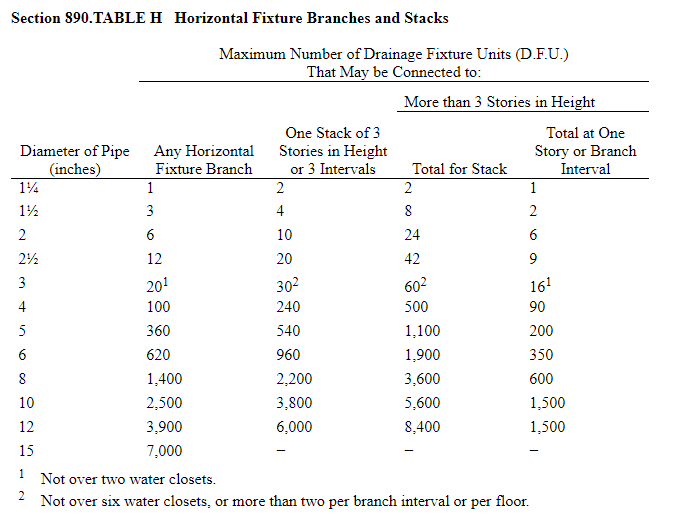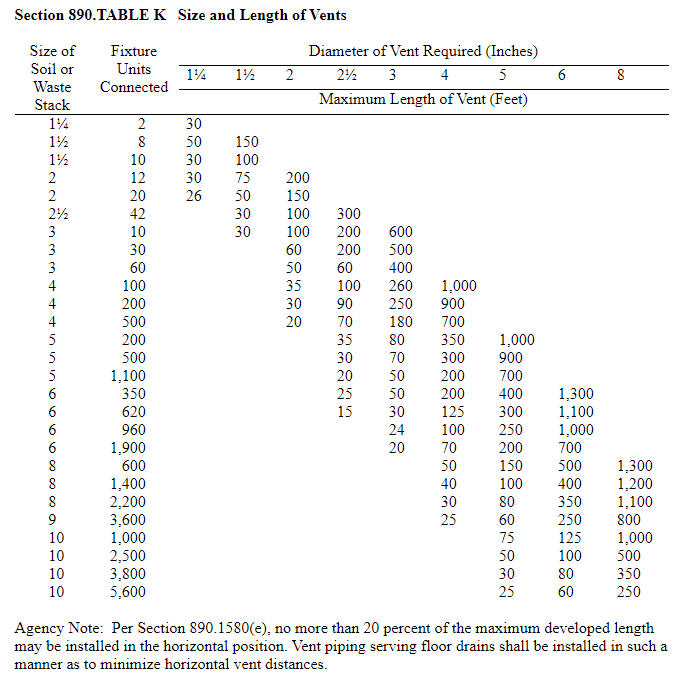Our village has adopted the Illinois Plumbing Code 1969 Edition; however, the calculations are very similar to other established codes. The online edition of the Illinois code has many helpful diagrams detailed in the appendices for common configurations.
SOME TERMINOLOGY
Entirely for the purposes of confusing you, plumbers don’t call a sink a sink, or a toilet a toilet. A handwashing sink in a bathroom is called a lavatory and a toilet is called a water closet. Toilets are further subdivided as tank operated—the kind in your house—or valve / flushometer operated—the high velocity flushing kind at schools, gas stations, and other public buildings.
HOW TO SIZE PLUMBING DRAINS
STEP 1: Adding up fixture units.
A (drainage) fixture unit (DFU) is a standardized way of adding up the supply and drainage requirements of various plumbing fixtures. For example, a bathtub (3 DFUs) obviously requires more drainage capacity than a bathroom sink / lavatory (1 DFU). Section 890 Table E Drainage Fixture Units per Fixture Group also has allowances for reducing the total number of fixture units when multiple fixtures are grouped together in rooms such as bathrooms. I have pulled the excerpts for common fixtures I intend to install, and included them in a table below.
| Fixture / Appliance | Drain Fixture Units (DFUs) |
| Residential Bathroom Group (sink, shower / tub, toilet) | 7 |
| Bathtub w/shower | 2 |
| Clothes Washer | 3 |
| Dishwasher | 2 |
| Lavatory (bathroom sink) | 1 |
| Kitchen Sink (w/garbage disposable) | 2 (3) |
| Toilet | 4 |
STEP 1: Draw a rough layout of how you intend to connect drain lines.
Create a schematic of what you intend to plumb. I drew a diagram in AutoCAD, but your diagram probably doesn’t need to be this advanced. A simple hand-drawn isometric drawing will do.
In my drawing, I show the relative location of each fixture and label the number of drainage fixture units it requires. I then follow the drain from the fixture to where it connects with other fixture drains and sum the fixture units as I go.

STEP 2: Calculate the required drain pipe size based on the number of fixture units.
Again, the Illinois Plumbing Code has a table (Section 890 Table H – Horizontal Branches and Stacks) for minimum pipe sizes. The requirements are different depending on whether your drain pipes run horizontally (horizontal branches) or vertically through each story (stack).
Let’s run through an example. You have a kitchen with a sink (3 DFUs) and a dishwasher (2 DFUs) for a total of 5 DFUs. According to the table, you would need at least a 2″ pipe to drain your kitchen. Note that the fine print has restrictions on the number of toilets allowed on certain pipe sizes regardless of the number of DFUs available.

HOW TO SIZE DRAIN VENTS
Vent sizing follows a similar methodology to drain sizing. Vents are sized based on the number of DFUs connected to them and the maximum length of the vent. Table K – Size and Length of Vents has all the values you need. Under sizing a drain vent is a big mistake and will inevitably lead to slow draining fixtures and gurgling drains.
For our kitchen example with 5 DFUs, we would need a 1-1/4″ PVC vent if the run was less than 50′, or a 1-1/2″ vent if we had to go further. As always, the code is only the minimum, so you can always go larger. Not being a professional plumber with a truck full of random fittings in all the common sizes, I intend to standardize around a few, larger-than-required fitting sizes (2, 3, and 4″).
